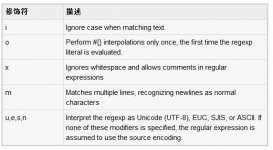在 class 定义里使用一致的结构。
|
1
2
3
4
5
6
7
8
9
10
11
12
13
14
15
16
17
18
19
20
21
22
23
24
25
26
27
28
29
30
31
32
33
|
class Person # extend and include go first extend SomeModule include AnotherModule # constants are next SOME_CONSTANT = 20 # afterwards we have attribute macros attr_reader :name # followed by other macros (if any) validates :name # public class methods are next in line def self.some_method end # followed by public instance methods def some_method end # protected and private methods are grouped near the end protected def some_protected_method end private def some_private_method end end |
倾向使用 module,而不是只有类方法的 class。类别应该只在创建实例是合理的时候使用。
|
1
2
3
4
5
6
7
8
9
10
11
12
13
14
15
16
17
18
19
20
21
|
# bad class SomeClass def self.some_method # body omitted end def self.some_other_method end end # good module SomeClass module_function def some_method # body omitted end def some_other_method end end |
当你希望将模块的实例方法变成 class 方法时,偏爱使用 module_function 胜过 extend self。
|
1
2
3
4
5
6
7
8
9
10
11
12
13
14
15
16
17
18
19
20
21
22
23
24
25
|
# badmodule Utilities extend self def parse_something(string) # do stuff here end def other_utility_method(number, string) # do some more stuff endend# goodmodule Utilities module_function def parse_something(string) # do stuff here end def other_utility_method(number, string) # do some more stuff endend |
When designing class hierarchies make sure that they conform to the
Liskov Substitution Principle.
在设计类层次的时候确保他们符合 Liskov Substitution Principle 原则。(译者注: LSP原则大概含义为: 如果一个函数中引用了 父类的实例, 则一定可以使用其子类的实例替代, 并且函数的基本功能不变. (虽然功能允许被扩展))
Liskov替换原则:子类型必须能够替换它们的基类型 <br/>
1. 如果每一个类型为T1的对象o1,都有类型为T2的对象o2,使得以T1定义的所有程序P在所有的对象o1都代换为o2时,程序P的行为没有变化,那么类型T2是类型T1的子类型。 <br/>
2. 换言之,一个软件实体如果使用的是一个基类的话,那么一定适用于其子类,而且它根本不能察觉出基类对象和子类对象的区别。只有衍生类替换基类的同时软件实体的功能没有发生变化,基类才能真正被复用。 <br/>
3. 里氏代换原则由Barbar Liskov(芭芭拉.里氏)提出,是继承复用的基石。 <br/>
4. 一个继承是否符合里氏代换原则,可以判断该继承是否合理(是否隐藏有缺陷)。
努力使你的类尽可能的健壮 [SOLID](http://en.wikipedia.org/wiki/SOLID_object-oriented_design\))。(
总是为你自己的类提供 to_s 方法, 用来表现这个类(实例)对象包含的对象.
|
1
2
3
4
5
6
7
8
9
10
11
12
|
class Person attr_reader :first_name, :last_name def initialize(first_name, last_name) @first_name = first_name @last_name = last_name end def to_s "#@first_name #@last_name" end end |
使用 attr 功能成员来定义各个实例变量的访问器或者修改器方法。
|
1
2
3
4
5
6
7
8
9
10
11
12
13
14
15
16
17
18
19
20
21
22
23
24
25
|
# bad class Person def initialize(first_name, last_name) @first_name = first_name @last_name = last_name end def first_name @first_name end def last_name @last_name end end # good class Person attr_reader :first_name, :last_name def initialize(first_name, last_name) @first_name = first_name @last_name = last_name end end |
避免使用 attr。使用 attr_reader 和 attr_accessor 作为替代。
|
1
2
3
4
5
6
7
|
# bad - creates a single attribute accessor (deprecated in 1.9)attr :something, trueattr :one, :two, :three # behaves as attr_reader# goodattr_accessor :somethingattr_reader :one, :two, :three |
考虑使用 Struct.new, 它可以定义一些琐碎的 accessors,
constructor(构造函数) 和 comparison(比较) 操作。
|
1
2
3
4
5
6
7
8
9
10
11
12
13
|
# goodclass Person attr_reader :first_name, :last_name def initialize(first_name, last_name) @first_name = first_name @last_name = last_name endend# betterclass Person < Struct.new(:first_name, :last_name)end |
考虑使用 Struct.new,它替你定义了那些琐碎的存取器(accessors),构造器(constructor)以及比较操作符(comparison operators)。
|
1
2
3
4
5
6
7
8
9
10
11
12
13
|
# goodclass Person attr_accessor :first_name, :last_name def initialize(first_name, last_name) @first_name = first_name @last_name = last_name endend# betterPerson = Struct.new(:first_name, :last_name) doend |
不要去 extend 一个 Struct.new - 它已经是一个新的 class。扩展它会产生一个多余的 class 层级
并且可能会产生怪异的错误如果文件被加载多次。
考虑添加工厂方法来提供灵活的方法来创建特定类实例。
|
1
2
3
4
5
|
class Person def self.create(potions_hash) # body omitted end end |
鸭子类型(duck-typing)优于继承。
|
1
2
3
4
5
6
7
8
9
10
11
12
13
14
15
16
17
18
19
20
21
22
23
24
25
26
27
28
29
30
31
32
33
|
# bad class Animal # abstract method def speak end end # extend superclass class Duck < Animal def speak puts 'Quack! Quack' end end # extend superclass class Dog < Animal def speak puts 'Bau! Bau!' end end # good class Duck def speak puts 'Quack! Quack' end end class Dog def speak puts 'Bau! Bau!' end end |
Avoid the usage of class (@@) variables due to their "nasty" behavior
in inheritance.
避免使用类变量(@@)因为他们讨厌的继承习惯(在子类中也可以修改父类的类变量)。
|
1
2
3
4
5
6
7
8
9
10
11
12
13
|
class Parent @@class_var = 'parent' def self.print_class_var puts @@class_var end end class Child < Parent @@class_var = 'child' end Parent.print_class_var # => will print "child" |
正如上例看到的, 所有的子类共享类变量, 并且可以直接修改类变量,此时使用类实例变量是更好的主意.
根据方法的用途为他们分配合适的可见度( private, protected ),不要让所有的方法都是 public (这是默认设定)。这是 Ruby 不是 Python。
public, protected, 和 private 等可见性关键字应该和其(指定)的方法具有相同的缩进。并且不同的可见性关键字之间留一个空格。
|
1
2
3
4
5
6
7
8
9
10
11
12
13
14
15
|
class SomeClass def public_method # ... end private def private_method # ... end def another_private_method # ... end end |
使用 def self.method 来定义单例方法. 当代码重构时, 这将使得代码更加容易因为类名是不重复的.
|
1
2
3
4
5
6
7
8
9
10
11
12
13
14
15
16
17
18
19
20
21
22
23
24
25
26
27
28
29
30
31
32
33
34
35
36
37
|
class TestClass # bad def TestClass.some_method # body omitted end # good def self.some_other_method # body omitted end # Also possible and convenient when you # have to define many singleton methods. class << self def first_method # body omitted end def second_method_etc # body omitted end endendclass SingletonTest def size 25 endendtest1 = SingletonTest.newtest2 = SingletonTest.newdef test2.size 10endtest1.size # => 25test2.size # => 10 |
本例中,test1 與 test2 屬於同一類別,但 test2 具有重新定義的 size 方法,因此兩者的行為會不一樣。只給予單一物件的方法稱為单例方法 (singleton method)。




